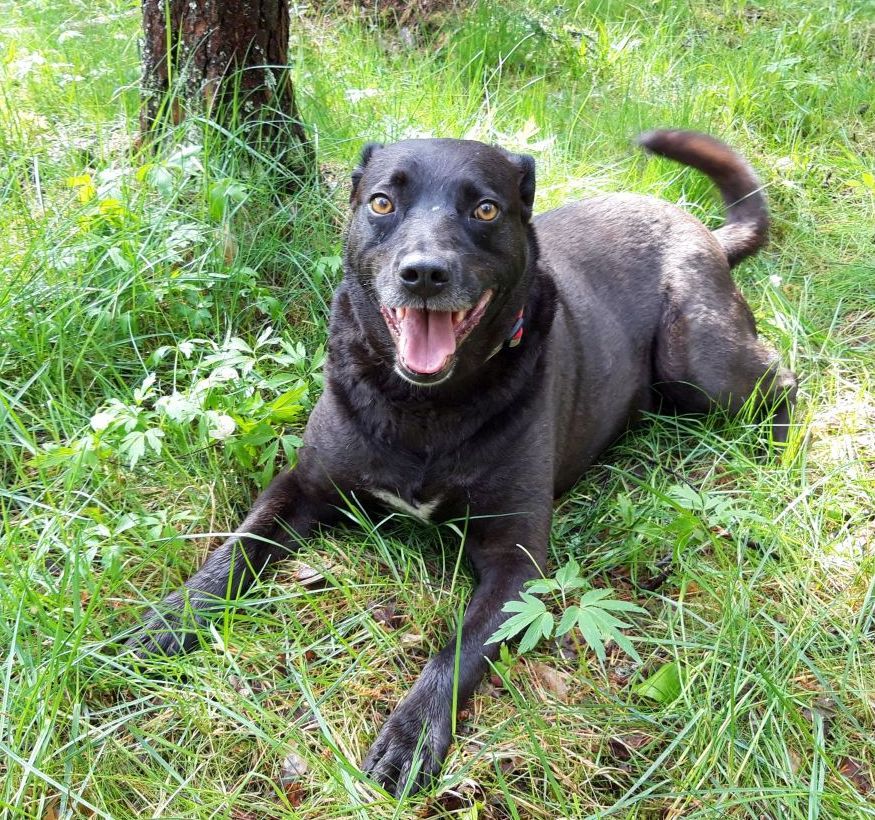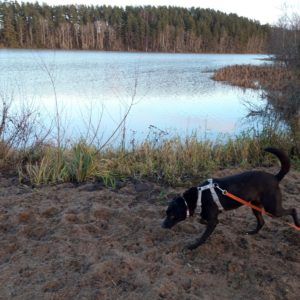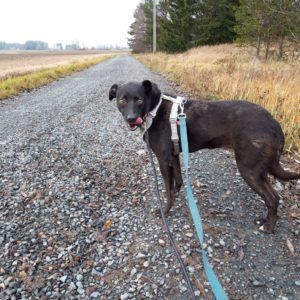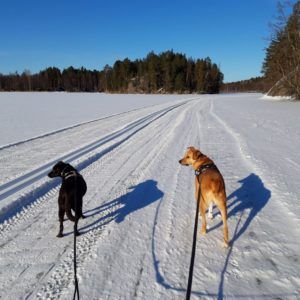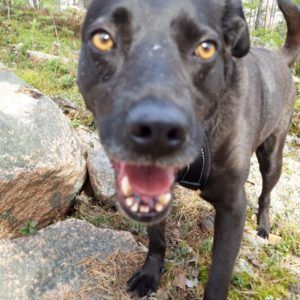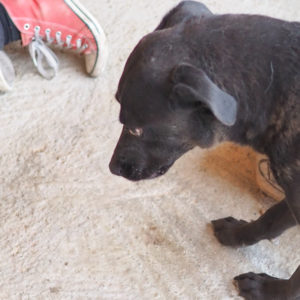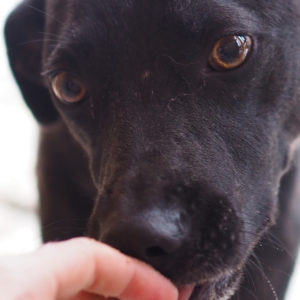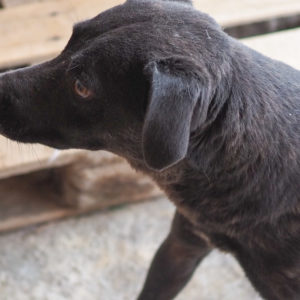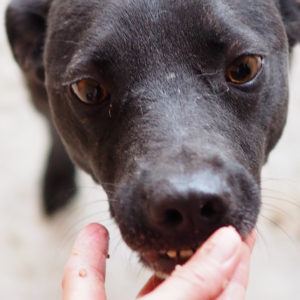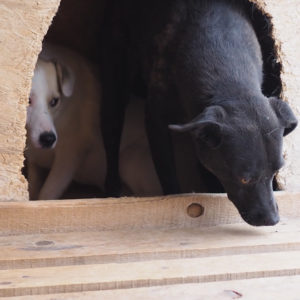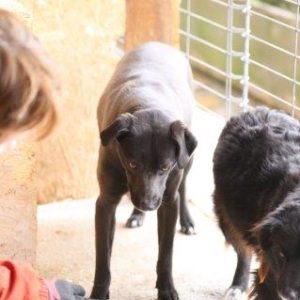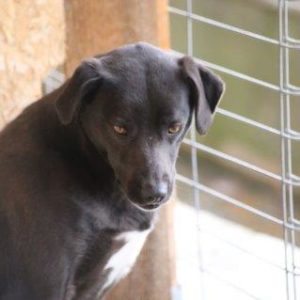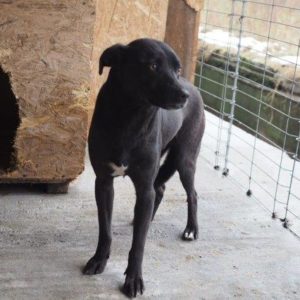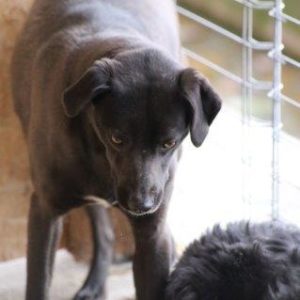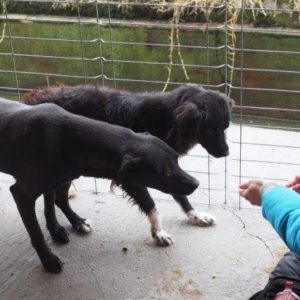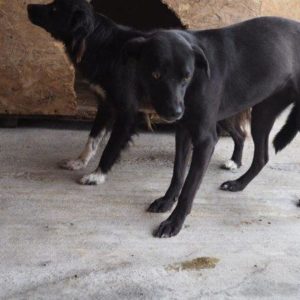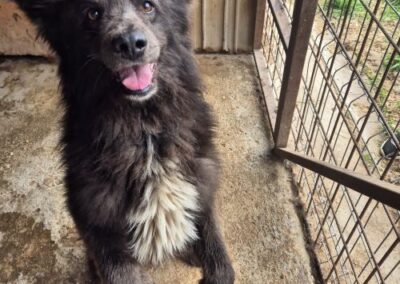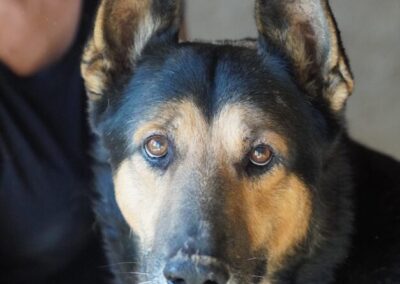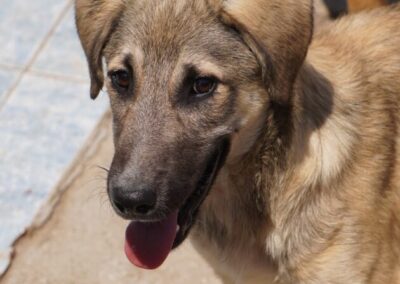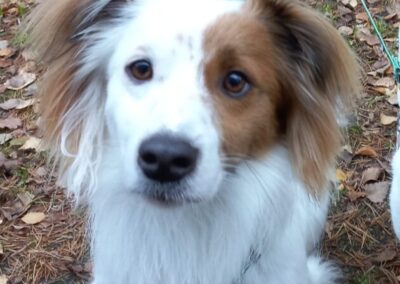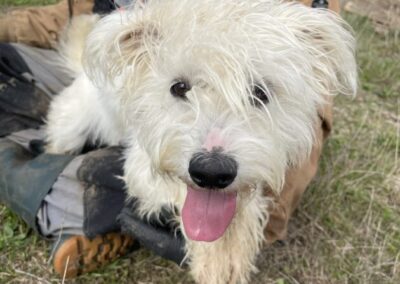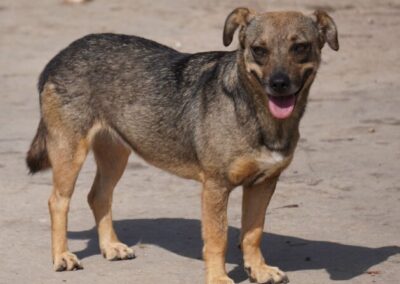Perustiedot
27.12.2019
One Rescue Associationin tarha Cosobassa on yksi Kulkurien keskeisimpiä yhteistyötahoja Romaniassa. Cosoba sijaitsee noin puolen tunnin matkan päässä Bukarestista. Siellä työskentelee väsymättä eläinlääkäri Adina Vladut, joka huolehtii jatkuvasti koirien lääkitsemisestä, adoptiovalmisteluista ja tarhan kehittämisestä. Kaikki kauttamme Suomeen saapuvat koirat kulkevat tämän tarhan kautta, jossa niille tehdään kaikki tarvittavat valmistelut lentoa varten.
Aktiivimme kävivät tarhalla taas joulukuussa 2019 ja kävivät myös Neldan häkissä, jonka se edelleen jakaa toisen ujon koiran kanssa. Nela viettää tällä kertaa suurimman osan vierailun ajasta kopissaan, se tulee piipahtamaan kopin ulkopuolella sen verran, että käy hakemassa namit maasta mutta ei tule tekemään tuttavuutta. Neldasta jää tunne, että se kuuluu niihin koiriin, joille tarhaolosuhteet vaan ovat liikaa. Liikaa sille, että koira pystyisi kehittymään tai reipastumaan sen enempää siellä. Se tulee vaatimaan sellaisen kodin ja perheen, jossa koirakokemusta on ennestään ja myöskin ymmärrystä herkän koiran sielumaailmasta.
Neldaa ei tulla luovuttamaan lapsiperheeseen, eikä kotiin joka sijaitsee sille liian vilkkaalla alueella. Joulukuun reissulta Neldasta ei ole uusia kuvia, sillä aktiivimme eivät halunneet stressata Neldaa ottamalla kuvia siitä, kun jo se, että he olivat siellä sen häkissä oli sille iso asia. Nelda hyötyisi aivan varmasti siitä, että kotona olisi reipas, kiltti ja avoin koirakaveri.
Syyskuun lopulla Nelda on antanut positiivisen testituloksen sydänmadosta. Tähän Nelda tulee saamaan hoitoa, ennen tuloa Suomeen.
Neldalla on korkeutta noin 45 cm ja painoa noin 18 kg. Sillä on lievä alapurenta.
Päivitykset
13.10.2021
Saimme ihania kuulumisia Florenceltä (ent. Neldalta), joka pikku hiljaa, omassa tahdissaan, on saanut reipastua omassa kodissaan. Tässä Florencen kotiutumistarina, perheen kirjoittamana:
“Welcome to the World, Florence!
I’ve worked with many fearful dogs over the years, in my capacity as both as a professional pet behaviour and training consultant, and as a volunteer in various animal rescues and shelters. During that time, I’ve seen only a few dogs who were truly shutdown, who would offer no behaviour whatsoever. They would cower in the corner or try to hide. They would not make eye contact or interact in any way.
Although I had seen it before, the first time I saw Nelda (now Florence) being carried out from the transport van at the event where I was going to adopt her, I have to admit I was a bit taken aback. She was absolutely terrified. She was obviously incredibly shut down. And that was completely understandable, given that she’d just been on a long road trip from Romania with a load of other dogs, and had no idea what was going on.
The rescue staff carried Florence over to me and put on the harness and collar I had brought with me. Then they left and it was just the two of us. Although Florence wouldn’t look with at me and obviously had no interest in interacting me with me, she ate a lot of the treats I had brought, so I knew that we had a starting point.
So I just let her be. I let her look around and take it all in without trying to force her to do anything. I saw other people cuddling their dogs or just hanging out with them giving them space to relax. Me? I was completely ignoring my dog! I didn’t talk to her and I didn’t look at her. I knew this was the best thing to do so as not to overwhelm her, but I also felt that other people would be looking at me wondering why I was ignoring her! Never mind though, I wanted her to understand that she could trust me. There would be plenty of time later to get to know each other.
When the time came to leave the adoption event we had to carry Florence out to the car because she wouldn’t walk. Her tail was tucked completely underneath her, flat against her belly. Her body was rigid. She was so scared it broke my heart. The drive home took about an hour. She didn’t make a sound the entire time, and she poked her head up once to look out the window, then retreated again. Once we got home she didn’t jump straight out of the car like I expected her to, like all our other dogs would do, but just sat there. She ate the huge dish of food we brought out, she drank more water and ate more treats, but still would not interact with us. That was fine, I didn’t have a problem with that. I just waited as far away as possible around the side of the car so as not to get in her space, while holding onto the leash in case she tried to make a run for it. However, after about an hour she still hadn’t moved and it was starting to get cold and dark. Plus she was so exhausted she was falling asleep, so we felt we had no option but to carry her into the house.
We carried her in on the bed that had been in the car, and set her up in a safe room of her own with another cosy bed, plus more food and water, and just closed the door and left her to it. She was so stressed you could see her little heart pounding in her chest. I knew we needed to give her as much time as she needed to calm down and realize that she was safe. And so for the next few days I took in her meals at a regular time so she knew what to expect and left her alone apart from that. Of course, I had to clean the floor a few times a day, so while I was doing that I would gently talk to her but not make eye contact. My goal was to let her know that she could trust me and that I wasn’t going to hurt or bother her, and that she could associate positive experiences with my presence. If she showed signs of stress such as a tongue flick, a yawn or a head turn, I would stop talking and turn my body away from her.
After a few days of this her little tail started to wag just a little bit when I went into the room. Even though she was still wedged in one corner, we were starting to see small signs of improvement. So I started to sit in the room with her, a few metres away so as not to crowd her, not touching her and not looking at her. I would just read news on my phone or play classical music. Occasionally I’d look at her and meet her eye briefly, then I’d turn away again so she knew I wasn’t a threat. As her confidence built, I started training her to sniff my hand and then give a treat, so she would learn to trust my approach as a good thing and not something to be scared of.
Soon we felt she was ready for us to leave her door open for short periods of time, but with a dog gate across the doorway so she could see the other animals and they could see her, and she could start to get familiar with the noises of the household. We had three other dogs and a few cats also, and we gave them all treats at the same time whenever they could see each other. We built it up very slowly so they could all get used to each other without having any physical contact, again setting them up for positive associations.
We worked on this for the next few weeks but Florence still showed no sign of wanting to come out of the room and explore the house, even during the times we left the gate open. Eventually, after a month had passed, we decided we might need to speed things up a little bit and so we carried her outside on her bed. She didn’t seem to understand what it meant to have a person holding a leash and standing so close to her. She was very uncomfortable with it and would walk just a few steps and then lie down. Sometimes she would stay lying down for sometimes 10-20 minutes, so I would stand there and wait for her while she did that for as long as she wanted to. I didn’t look at her or talk to her or try to coax her to move. I just let her make her own choices.
We also had our other rescue dog Roman who helped a lot and showed Florence that it really was safe to be around us. Based on what I had learned so far, I decided to put her on a long line so I wouldn’t have to stand so close but could be sure she wouldn’t be able to run off (because she still didn’t really trust me at that point). The 10-metre line I used worked really well because she had the freedom to explore a little bit without me being right behind her all the time.
Next, I started taking her for little walks along the small farm track by our house, which worked fine, even though she was quite scared and was very vigilant and constantly scanning the landscape. However, the first time we did that I realised I’d made a bit of a mistake – I didn’t take any treats with me! And so when the time came to turn around to go back home (because I didn’t want to go too far the first few times) there was no incentive for her to turn around. She didn’t understand the concept of going back home and she still didn’t trust me yet. I had no option but to circle back around behind her, which was not ideal at all, but worked – because she didn’t want me to be too close to her and would actively move to get further away from me.
The next day I was sure to take some treats and, when I wanted her to turn to go back home, just threw them on the ground in a curve for her to follow. I wasn’t sure if she would be too scared to eat them, but she wasn’t (she is a very food motivated dog!), and so it worked great. From then on I took her for walks with Roman so that he could provide canine support and show her it was safe. She could see he was confident and relaxed with me, that he was engaging with me and the environment. I was so thrilled when she started sniffing the ground and digging a little hole! Once we’d done a few of these short walks with Roman we got into a really good routine and started to go further and further. I had already trained her on the long line so she knew to come back when she was called and not to run off if she got scared. But it wasn’t until about six months later than I felt confident enough to allow her to be off leash on one of our walks. She just stayed close by but still did her own thing and it worked beautifully, I was so proud of her!
One night after she’d been with us for about six weeks, she quietly came out of her room and jumped up to sit next to me on the sofa. I couldn’t believe it. I didn’t dare to breathe or move a muscle in case I scared her. She stayed for quite a while, and then left and went back to her safe room. I knew we’d turned a corner!
About a week previously, I had started sitting outside her room on the floor a couple of metres away and tossing down treats to encourage her to venture out of the room. After a few days of this, she started coming out on her own when we left the dog gate open for short periods of time. She’d come out and see what everyone was doing, then turn round and run back to her room. She would do this many, many times a day, and we just let her do her thing. We wanted her to know she could go back to her safe room whenever she wanted to and that no one would bother her there. Over the coming months she started to spend longer periods of time out of her room and with the other dogs, but we always allowed her to make the choice to remove herself if she wanted to. It was the same when we were outdoors on the long line. She could always go back to the house whenever she wanted to. Out number one goal was to make sure she always felt safe.
As I write this, it’s coming up to a year now since we adopted Florence (October 10, 2020) and she makes us laugh every single day. Her little (or should I say, big) personality has really come out and she’s quirky and funny. She’s got her little habits and still loves her food. We do really long forest walks now and she absolutely loves Roman. They do everything together – run, play, wrestle, and take naps. He has helped her more than we ever could.
For a dog like Florence, and any dog that is coming to a new home, the best thing you can ever do at the beginning is to do nothing. Let them have their own safe space and allow them time to de-stress and regroup. Let them understand that they are safe, and keep them to a routine so they know what to expect. Give them the freedom to make their own choices so that they feel in control, which builds their confidence. The key is to work to their timeline and not yours, and not overwhelm them. Patience is absolutely essential.
In the end I wouldn’t say working with Florence has been a challenge at all. She is a very quiet, sweet and easy dog compared to some of the fearful dogs we have had in the past. But it was very important that we let her do things in her own time and not rush her. We absolutely love having her as part of our family and are so happy that have the chance to give her the life she deserves, after spending her first five years in the shelter.
Follow @homeofthecatanddoghouse on Instagram to see more photos and videos of Florence enjoying her new life with her cat and dog siblings!
Text and photos © Susan Nilson 2020-2021″
10.10.2020
Jotkut koirat kestävät tarhaoloja huonommin kuin toiset. Ne vetäytyvät kuoreensa, eikä niiden todellinen luonne pääse esille. Onneksi kuitenkin joskus näitäkin koiria onnistaa ja ne saavat mahdollisuuden. Nelda, nyt Florence, pääsi monen vuoden tarhalla olon jälkeen matkustamaan Suomeen ja nyt hän totuttelee elämään kotikoirana, kokeneessa ja ympäristöltään Neldan kaltaiselle koiralle täydellisessä kodissa. Häntäkin jo heiluu, kun omat ihmiset puhuvat hänelle.
9.8.2020
Neldan elämä on tekemässä täysikäännöksen ja hän pääsee vihdoinkin pyyhkimään tarhan tomut ja liat tassuistaan ja turkistaan. Nelda on varattu omaan kotiin.
27.12.2019
Neldalle etsitään koirakokemusta omaavaa, ymmärtäväistä, rauhallista aikuiskotia.
19.9.2019
Aktiivimme tapasivat syyskuun reissullaan myös suloisen Neldan. Se tulee jälleen varovasti tervehtimään, ja ottaa nameja myös kädestä. Silityksille ja kosketuksille tyttö ei vielä antaudu. Kesken vierailun Nelda säpsähtää äkillistä ääntä ja pinkaisee koppiin, mutta tulee välittömästi takaisin namien äärelle. Neldan iholla on tällä hetkellä kirppujen aiheuttama paha ihottuma, johon se saa hoitoa. Musta kaunotar on rauhallisen oloinen, joskin ujoudessaan vielä hieman reppana. Nelda selvästi motivoituu herkuista, mikä helpottaa myös luottamuksen rakentamista tulevassa kodissa. Sillä jossakin se oikea koti odottaa herkkistyttöä, ihan varmasti!
15.8.2019
Nelda on edelleen varovainen ja herkkä tyttönen, joka on kuitenkin utelias ja selvästi kiinnostunut vierailijoista. Alkuun se uskaltaa ottaa nameja vain maasta, mutta hetken ihmeteltyään se ottaa namin myös tutun Adinan kädestä ja myöhemmin myös suoraan vieraalta aktiivilta. Nelda on kiinnostunut hajuista ja haisteleekin esimerkiksi vierailijoiden käsiä mielellään. Nelda tulee vaatimaan tulevalta kodiltaan kärsivällisyyttä ja aikaa.
10.6.2019
Häkkiin saapuneet aktiivit selvästi ujostuttavat Neldaa, mutta tyttö tulee kuitenkin kopista hakemaan nameja ja jää kopin ulkopuolelle eikä pujahda heti suojaan. Ruoka selvästi motivoi Neldaa ja namien avulla se uskaltaakin tulla lähemmäksi. Nelda asuu tällä hetkellä todella aran koiran kanssa, mikä ei ole optimaalista, koska tällöin käytös vain vahvistuu, eikä Nelda saa reippaammalta koirakaverilta tukea. Tutumman Adinan kanssa Nelda on reippaampi ja utelias koira rentoutuu hieman myös aktiivien vierailun aikana. Neiti tulee hyvin toimeen häkkikaverinsa kanssa ja ujopiimä hyötyisikin varmasti reippaasta koirakaverista.
28.3.2019
Kaunis Nelda tavattiin taas maalikuun reissulla. Se haluaa kovasti uskaltaa tulla lähelle, ja ihmiset ovat selvästi kovin kiinnostavia, mutta jännittää silti vierailijoita. Tyttönen kuitenkin reipastuu vierailun aikana melko nopeasti ja hetken kuluttua tulee aktiivien luo ja myös jää ihmisten lähelle. Nelda kaipaa kuitenkin tulevalta kodiltaan rauhallisuutta ja kykyä lukea hieman epävarmempaa koiraa, jotta se pääsisi kuorestaan ulos.
10.12.2018
Kaunokainen aloitti oman kotinsa etsinnän Kulkurien adoptio-ohjelmassa.
Mietithän tarkkaan omia resurssejasi harkitessasi rescuekoiran adoptiota. Onko sinulla aikaa, motivaatiota ja sitoutuneisuutta koiraan? Aikuisenkin koiran kohdalla sitoutuminen voi olla parhaillaan useiden vuosien mittainen. Muistathan myös, että kotikoiran tavat eivät ole tarhaoloista tulleille useinkaan tuttuja, eikä voida olettaa, että koira kulkisi hihnassa heti vaivattomasti, olisi tottunut sisätiloihin ja työpäivän mittaiseen yksinoloon tai jättäisi tavarasi rauhaan. Tiedossa on varmasti töitä ja takapakkia, mutta myös iloisia hetkiä ja onnistumisen riemua.
Muistathan myös, että koiran kuvaus on kirjoitettu tarhaolosuhteissa tehtyjen havaintojen perusteella ja käytös voi kotiutumisen edetessä muuttua.
Nelda saapuu Suomeen steriloituna, asianmukaisesti rokotettuna, ulko- ja sisäloishäädettynä ja testattuna useiden sairauksien varalta. Lisäksi Nelda on mikrosirutettu ja sillä on EU-lemmikkipassi. Rescueyhdistys Kulkurit ry kuuluu Responsible Rescue -sitoumukseen ja noudattaa sitoumuksen kriteereitä koirien maahantuonnissa.
Tutustuthan ennen yhteydenottoasi sivuiltamme löytyviin luovutussopimukseen, oppaaseen kotiutuvan koiran omistajalle, sekä adoptoitavan eläimen terveyteen ja kustannuksiin.
Yhteyshenkilö: Mia Takolander
- Florence (ent. Nelda) omassa kodissa
- Florence (ent. Nelda) reippaana rannalla
- Florence (ent. Nelda) kotona
- Florence (ent. Nelda) ja koirakaveri
- Iloinen Florence (ent. Nelda)
- Hmm, nameja… Nelda 9/2019
- Hiukan ujottaa… Nelda 9/2019
- Nelda 9/2019
- Sehän oli hyvää. Nelda 9/2019
- Kaunis tyttö! Nelda 9/2019
- Uskallan ottaa herkkuja! Nelda 9/2019
- Omassa kopissa on välillä turvallista hengähtää. Nelda 9/2019
- 5/2019
- 3/2019
- 3/2019
- 11/2018
- Nelda 9/2019
- 5/2019
- Kirppujen aiheuttamaa karvanlahtöä, jota hoidetaan. Nelda 9/2019
- 3/2019
- 11/2018
- 11/2018
- 11/2018

